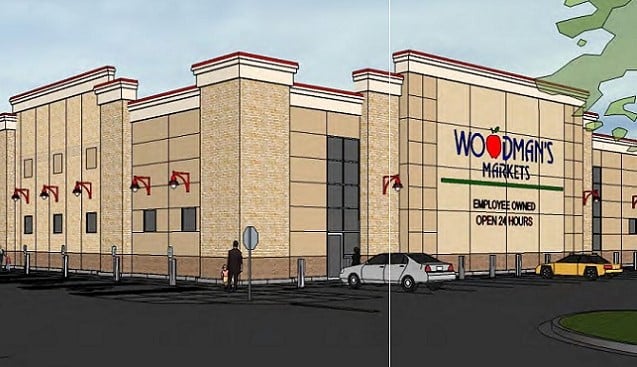 In suburban Buffalo Grove, Woodman’s Market will anchor this 236,000-square-foot center due for completion later this year, one of the few major new retail projects in the region.
In suburban Buffalo Grove, Woodman’s Market will anchor this 236,000-square-foot center due for completion later this year, one of the few major new retail projects in the region.
CHICAGO—As reported in GlobeSt.com, a new report from Marcus & Millichap states that vacancy among the Chicago region’s retail properties has tightened to the lowest level in 10 years. Furthermore, according to its 2018 forecast, that rate will drop a further 64 bps after an estimated 4.4 million square feet of absorption. But one of the reasons for that decline is that developers have remained careful about building new spaces, partly because the competition from e-commerce has made the future of many retail outlets so uncertain.
“Construction for retail properties today is definitely less than in the pre-recession years,” Austin Weisenbeck, senior vice president of investments, Marcus & Millichap, tells GlobeSt.com. “The slowdown is predominantly due to fewer tenants actively expanding right now, and lenders being more cautious about providing financing until a property is near fully leased. Many retailers are in the process of redefining themselves as the industry continues to evolve and adjust as consumers do more of their shopping online.”
Developers delivered 2.1 million square feet of new space last year, and in 2018 that number will shrink to 1.7 million, according to Marcus & Millichap. That would be the lowest amount since 2012, but still a fraction of what was completed in 2008. And along with that more cautious attitude, another subtle shift is underway.
In the recent past, “developers were more focused on urban development due in part to the perceived safety of building in densely populated areas,” says Weisenbeck. “The demand is there, especially with the younger generations preferring a city lifestyle and companies relocating downtown to attract younger talent.” However, “the city has become a bit saturated in certain neighborhoods, and the cost of land and construction in the city makes many developments hard to pencil out.”
Downtown Chicago will only see about 300,000 square feet of new inventory this year, according to Marcus & Millichap, and the suburbs are finally seeing some pick-up in development. Still, density remains quite important, and Weisenbeck says “the construction occurring right now in the suburbs is mostly relegated to the municipalities surrounding Chicago.”
And the fact that most of new retail in Chicago will be within mixed use and residential projects is another sign of caution. Lincoln Commons, for example, a mixed-use development on the former Children’s Memorial Hospital site in Lincoln Park, will provide roughly 100,000 square feet of new retail space in 2018 along with nearly 600 residential units.
“Retailers have always wanted to be as close to their patrons as possible. Occupying space within a mixed-use building offers a built-in customer base,” Weisenbeck says. “Furthermore, with the cost of land on the rise over the last five years, developers can’t justify the cost of a single-use building. Rather, they need a means to spread the cost across a larger buildable area, oftentimes with the stability that comes with a multifamily component.”

















 Copyright © 2024 ALM Global, LLC. All Rights Reserved.
Copyright © 2024 ALM Global, LLC. All Rights Reserved.